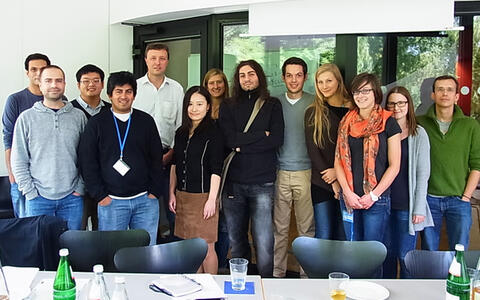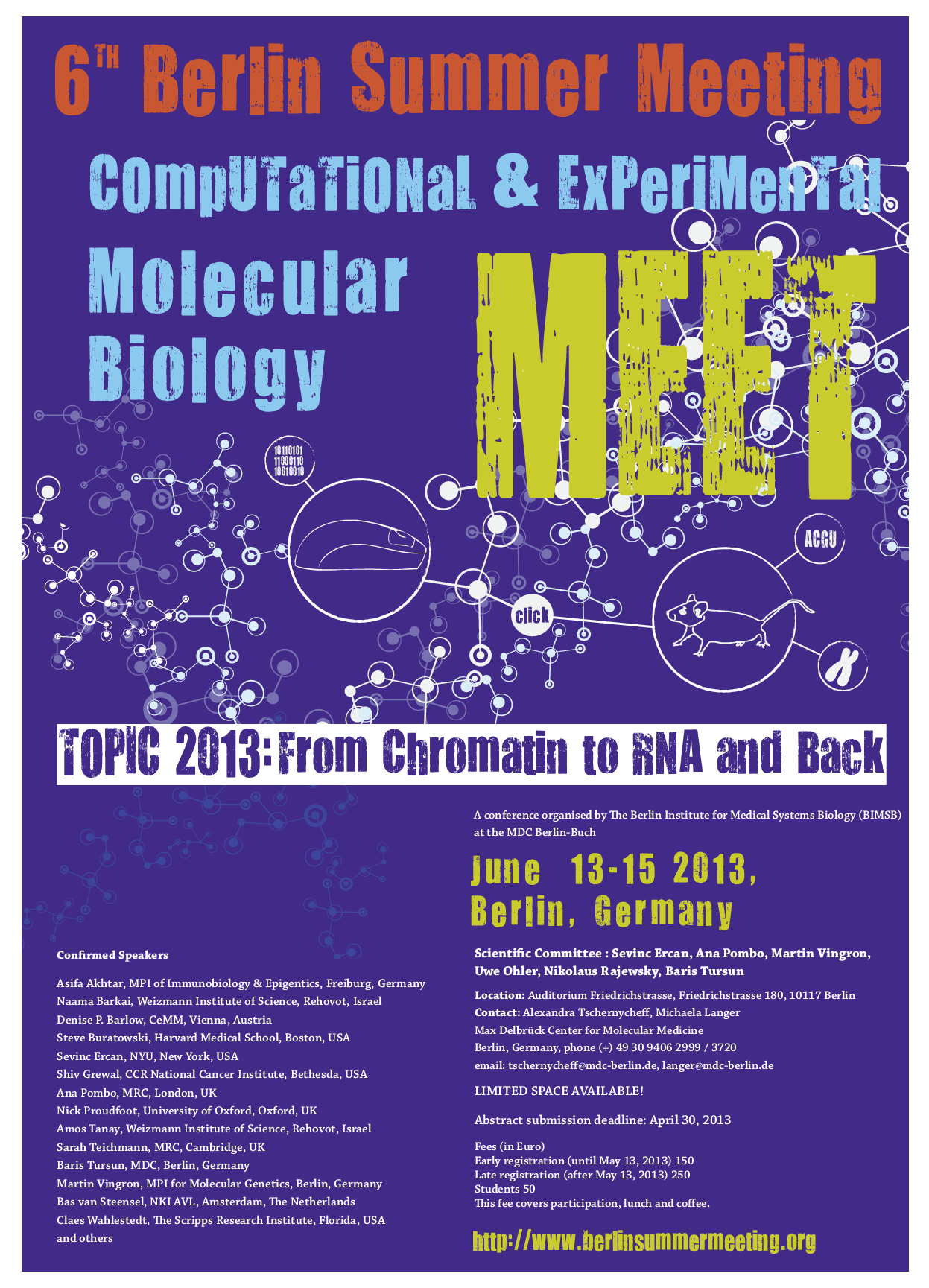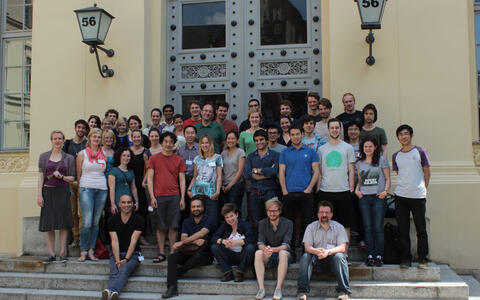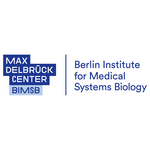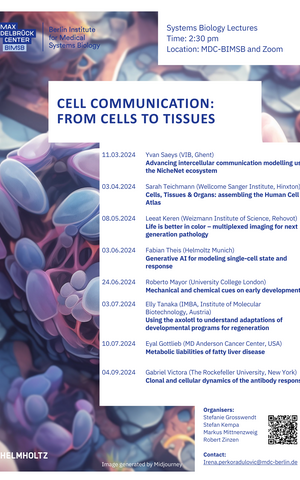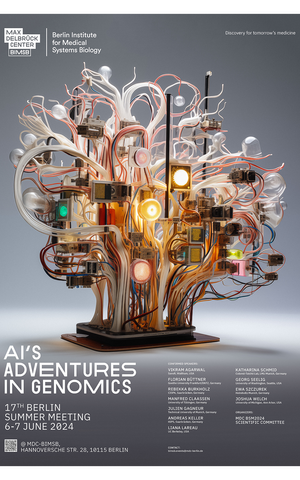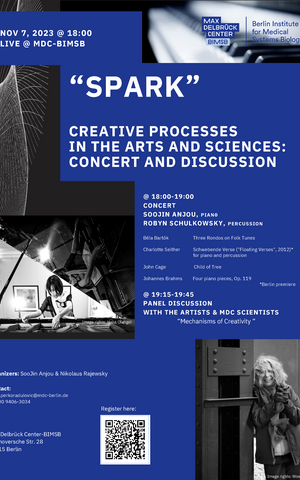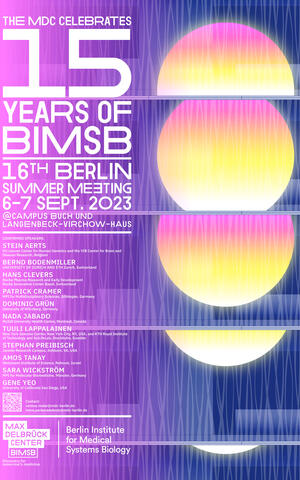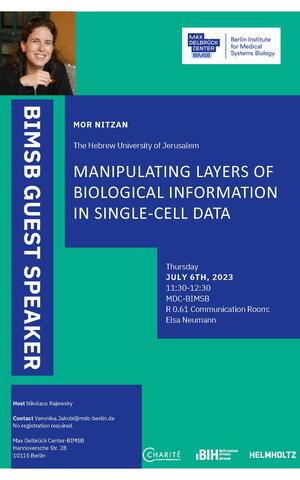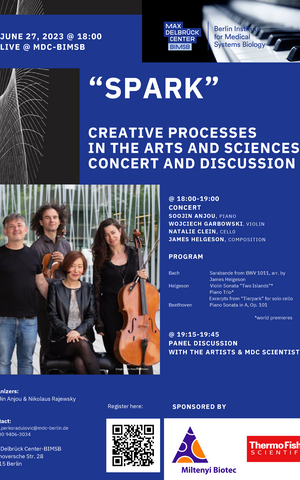
Berlin Institute for Medical Systems Biology (MDC-BIMSB)
News in 2013
October 2013
LECTURE SERIES: Scientific colleagues from Campus Buch, Berlin, and the Hebrew University of Jerusalem join together in Winter Semester 2013/14 to present the Systems Biology Lectures in Methods & Technologies. All are welcome to attend.
October 2013
SECOND BIMSB RETREAT
Over 100 scientists and students came together on September 24-26, 2013 at Landhof Arche, Groß Pinnow for the second BIMSB retreat. Over three days, the established and new BIMSB groups took the opportunity to get to know each other's science as well as exchange ideas and perspectives with invited BIMSB associated groups. Highlights included a round table careers discussion and an overview of milestones reached and challenges yet to be met in the establishment of the new institute and its scientific agenda. Program
September 2013
SEMINAR SERIES: Patrick Cramer - Distinguished Speaker in the BIMSB Seminar Series
Patrick Cramer from the Gene Center Munich gave a very well attended talk as a distinguished speaker in the Systems Biology (BIMSB) Seminar Series. Apart from discussions with group leaders, he also met some of our students and postdocs and discussed with them during lunch, fueled by some sandwiches.
Discussions were lively and spirits were high. Thanks Patrick!
September 2013
SEMINAR SERIES: Mike Levine gives inaugural seminar in the BIMSB Distinguished Speaker series
As part of BIMSB's new seminar series that aims to bring distinguished scientists from all over the world to Berlin, Michael S. Levine, Professor of Molecular and Cell Biology at UC Berkeley visited our campus on June 19 and 20, 2013 to deliver two well-received lectures and to meet with BIMSB and MDC faculty.
BIMSB was very happy to host Mike Levine, one of the most-renowned developmental biologists of our time. Mike is probably most famous for the discovery of the homeobox in 1984 together with William McGinnis and Ernst Hafen, as well as for his pioneering enhancer studies in the even-skipped locus in Drosophila melanogaster. Over the years, his lab has focused on understanding how transcription is regulated and drives development by employing cutting-edge technologies such as transcriptomics, genomics, and mathematical modeling.
On the 19th, Mike gave a lecture in the series Systems Biology Lectures in Development at the Charitè campus in Berlin-Mitte to a crowd of mostly students from all over Berlin. The lecture titled "Mechanisms of transcriptional precision and timing in the Drosophila embryo" illustrated recent work in his lab on how transcriptional regulatory elements can work combinatorially to yield coherent and robust gene expression across a cell population, and how pausing of polymerase at promoters can be a means of achieving a more synchronous onset of transcription – features that are both crucial for proper embryonic development.
On the 20th, Mike held the BIMSB Distinguished Speaker Seminar on our campus in Berlin-Buch. Titled "Evolutionary origins of the vertebrate neural crest and new mouth in the Ciona tadpole", the lecture focused on Evo-Devo analyses of the origins and transcriptional underpinnings of heart development in Ciona intestinalis, a marine chordate and among the closest non-vertebrate relatives to modern vertebrates. Furthermore, Mike speculated that two pigmented sensory cells within the Ciona tadpole, the otolith and the ocellus, could be the orthologous 'rudiments' to the neural crest – a key innovation in vertebrates.
June 2013
CONFERENCE: Berlin Summer Meeting 2013 - From Chromatin to RNA and back
120 participants met over 3 days at the Auditorium Friedrichstraße in downtown Berlin for the 6th Berlin Summer Meeting. The meeting took us on a tour into the core of gene regulation at the chromatin level, from the fine details of promoter structure, to how chromatin folds in three-dimensions inside the nucleus, to how RNAs are made in a process influenced by chromatin features that in turn influences chromatin states. It was hard to tell which speaker uses biochemical, genetics, computation, or other methods, single gene analyses or genome-wide approaches, as in almost every talk we went from one to the other in a seamless manner. Of note were the exciting discussions that followed every talk, and the exceptional quality of all the short talks from our more junior guests.
June 2013
SUMMER SCHOOL: Berlin Summer School 2013 - Epigenetics
41 graduate students and postdocs took part in the first BIMSB coordinated Berlin Summer School on the topic of Epigenetics at the Humboldt Graduate School, Luisenstr. 56, Berlin.
The participants from labs in Germany, Austria and Belgium took part in 3 full days of scientific activity with 14 speakers and a study visit to the Berlin Museum of Natural History. Further information on the event can be found in the program.
June 2013
PUBLICATION: New integrated microRNA target site identification
Supported by collaborators in Bryan Cullen's lab at Duke University, researchers in Uwe Ohler's group have developed an integrated computational approach to assign specific microRNAs to target sites with high confidence. The approach is the first to combine "traditional" sequence characteristics of target sites with cutting-edge experimental data that helps to pinpoint the locations of microRNA interactions.
MicroRNA target site identification by integrating sequence and binding information (Nature Methods)
May 2013
LECTURE SERIES: Scientific colleagues from Campus Buch, Berlin, and UC Berkeley join together in Summer Semester 13 to present the Systems Biology Lectures in Development. All are welcome to attend.
April 2013
COLLABORATION: BIMSB contributes to the new "Integrative Research Institute for Life Sciences", IRI-LS – a collaboration of Humboldt University Berlin, Charité and MDC
Jan-Hendrik Olbertz, HU President, Annette Grüters-Kieslich, Charité Dean, and Walter Rosenthal, MDC Director, together with representatives of the BMBF and the Senate of Berlin as well as many scientists and members of the three institutions inaugurated the IRI-LS. Andreas Herrmann summarized the mission and future developments of the Life Sciences in Berlin, scientific projects, campus development at the northern Humboldt Campus, new recruitments and expansions of state-of-the-art technologies. As a guest and friend to Berlin scientists, nobel laureate Aaron Ciechanover gave an outstanding commemorative lecture, on the history and recent biomedical achievements in the filed of personalized medicine, their potential of implementation and resulting ethical and social questions in our daily lives.
March 2013
Outside perspective of the architect’s plan for the new MDC building for BIMSB in Berlin Mitte. The architect’s office Staab from Berlin has been awarded with the first prize of the MDC’s architectural competition. (Copyright: MDC)
New MDC building for the Berlin Institute for Medical Systems Biology - The decision has been taken
The design for the new building for BIMSB in Berlin Mitte was recently selected through an architectural competition. The building will integrate perfectly into the given setting at the Humboldt Campus Nord. It will house up to 25 research groups, approximately half experimental and half computational, providing 5400 qm of laboratory and office space. The building supports high-tech-labs, flexible workspaces and communication areas, which are all essential for the planned innovative and interdisciplinary work at the BIMSB. The activities are integrated in the development of the life sciences in Berlin: together with the Humboldt University and the Charité Berlin, BIMSB is part of the Integrative Research Institute for Life Sciences IRI-LS.
Construction is scheduled to start in 2015 and the the new building is planned to be ready in 2018.
February 2013
PUBLICATION: Discovery of cicular RNAs (circRNAs) as a large class of animal RNAs with regulatory potency
The Rajewsky lab, in collaboration with the le Noble lab and other MDC researchers, have combined biochemical, computational, and functional data to show that circRNAs are a large class of animal RNAs with often tissue/developmental stage specific expression. They have further shown that circRNAs can function to bind miRNAs, therefore effectively interfering with miRNA-mediated regulation. These findings, together with the extreme stability of circular RNAs, make circRNAs interesting candidates for biomarkers and possibly therapeutic agents.
Circular RNAs are a large class of animal RNAs with regulatory potency (Nature)
Circular RNAs throw genetics for a loop (Nature)
Circular RNA Surprise (The Scientist)
Circular RNAs: splicing’s enigma variations (EMBO Journal)
Squaring the RNA circle (SciBX)
Linking Long Noncoding RNAs to Function (CELL comment)
RNA: Circular RNAs as miRNA sponges (Nature Reviews Molecular Cell Biology)
Circular sponges (Nature Reviews Genetics)
February 2013

